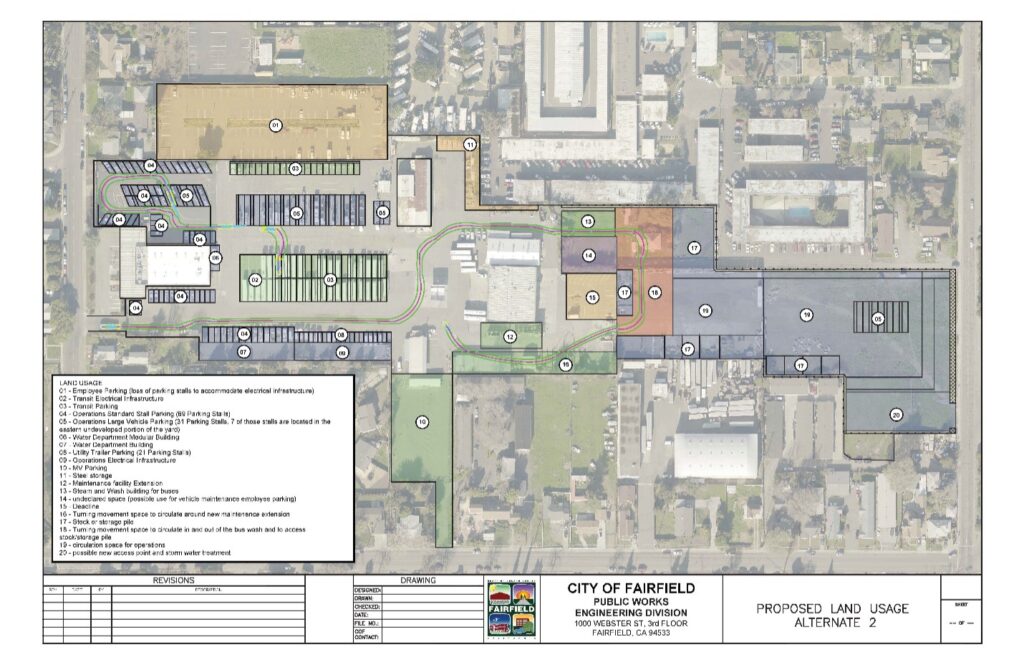To ensure California’s transportation sector reduces greenhouse gas emissions, the California Air Resources
Board’s (CARB) adopted an Innovative Clean Transit (ICT) regulation in December 2018. The ICT has mandated all public transit agencies to reduce greenhouse gas emissions by gradually transitioning to a 100 percent zero emission bus (ZEB) fleet. Beginning in 2029, 100% of new purchases by transit agencies must be ZEBs with a goal of full transition by 2040.
Prior to the ICT, FAST had already initiated electrification of its fleet. In 2016, the Fairfield City Council adopted FAST’s Alternative Fuels and Fleet Replacement Policy. FAST concurrently began competitively applying for grants to offset electrification infrastructure improvement costs and ZEB purchases. These efforts resulted in FAST successfully being awarded two competitive Federal Transit Administration (FTA) electrification grants totaling $2.4 million dollars, which provided further impetus for FAST to begin electrifying its fleet.
FAST houses and maintains its fleet at the City of Fairfield’s Corporation Yard. FAST shares use of the Corporation Yard with the City of Fairfield Public Works’ Operations and Fleet Divisions. The age of both the City’s Corporation Yard that houses FAST’s fleet and its vehicle maintenance facility have complicated and delayed FAST’s electrification implementation. Because CARB is also mandating the transition of medium- and heavy-duty vehicles to zero-emission, FAST has closely coordinated with City Public Works Operations, Fleet, and Engineering Divisions to develop a layout of how the Corporation Yard can accommodate all Public Works’ future growth and electrification infrastructure upgrades as shown below.

In Spring 2020, FAST began work on the FAST Electrification Plan (FTEP) to continue moving towards fleet electrification. FAST along with the City of Fairfield’s Fleet Division, executed a contract with PG&E under their EV Fleet Program securing 1,360kW of additional electricity to charge electric vehicles. The FTEP will take FAST’s initial efforts a step further by developing a business plan to transition FAST’s transit fleet to an all-electric zero-emission fleet before 2035. The current draft was finalized in Spring 2023, the FAST Electrification Plan provides a comprehensive road map that includes phased implementation and fleet replacement plans. The FTEP will also include short-, medium-, and longer-term cost estimates for FAST to effectively plan for the transition to an all-electric fleet in less than fifteen years.
Part of the FTEP planning process will include an analysis of the following areas:
- Technology of battery electric vehicles (BEVs),
- Infrastructure upgrades,
- Maintenance facility expansion, and
- Funding needs.
The first phase will lay the necessary groundwork for the City to continue expanding and converting its transit fleet to BEVs. The FTEP draft plan recommends Phase I of FAST Electrification include the following project elements:
- Replacement of five (5) fixed-route diesel buses and four (4) cutaway gasoline paratransit vehicles with fully electric zero-emission vehicles,
- Site improvements and supporting infrastructure upgrades that allow for the operation of battery electric transit vehicles,
- Procurement and installation of six (6) dual port 150kW chargers, and
- Expansion and modernization of the vehicle maintenance facility by four (4) additional service bays to ensure City of Fairfield’s Fleet Division can safely maintain BEVs onsite.
In August 2022, FAST was awarded $12,016,400 from FTA for transit electrification. Along with other anticipated state funding commitments, this competitive grant award should provide enough funding for the City of Fairfield to complete the first phase of transit electrification.
FAST is taking the steps outlined below to move forward seamlessly with this mandated transition:
- Complete full design of the Corporation Yard civil and electrical upgrades,
- Complete design of maintenance facility upgrades,
- Redesign routes as needed to maximize charging,
- Receive and place into service its first BEBs,
- Install charging stations, and
- Plan for and apply for additional funding opportunities for future phases.
Many of these steps will be completed concurrently. For example, the Fairfield City Council authorized FAST’s
purchase of its first three (3) Gillig BEVs in July 2022 that are scheduled to arrive in January 2024. Design and engineering for electrical upgrades and infrastructure started in June 2023. FTA and Transportation Development Act (TDA) funding will be used for these projects. The most important element for FAST to successfully electrify its fleet will be to plan for enough electrical capacity to support future technology and to use some form of electrical load management to maximize control of ongoing utility costs. FAST will also continue to outreach to other peer agencies to continue learning from other agencies’ electrification experiences.